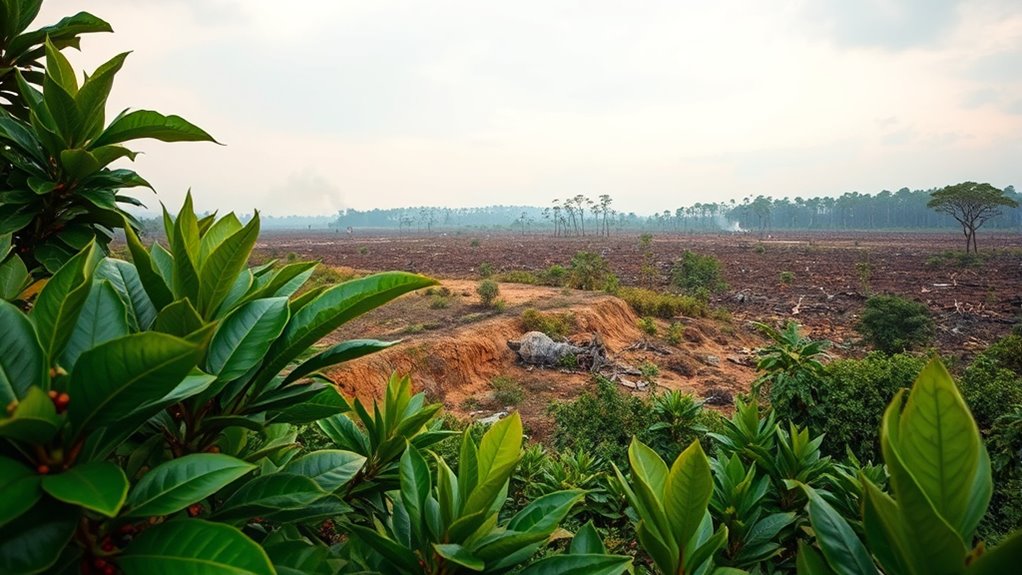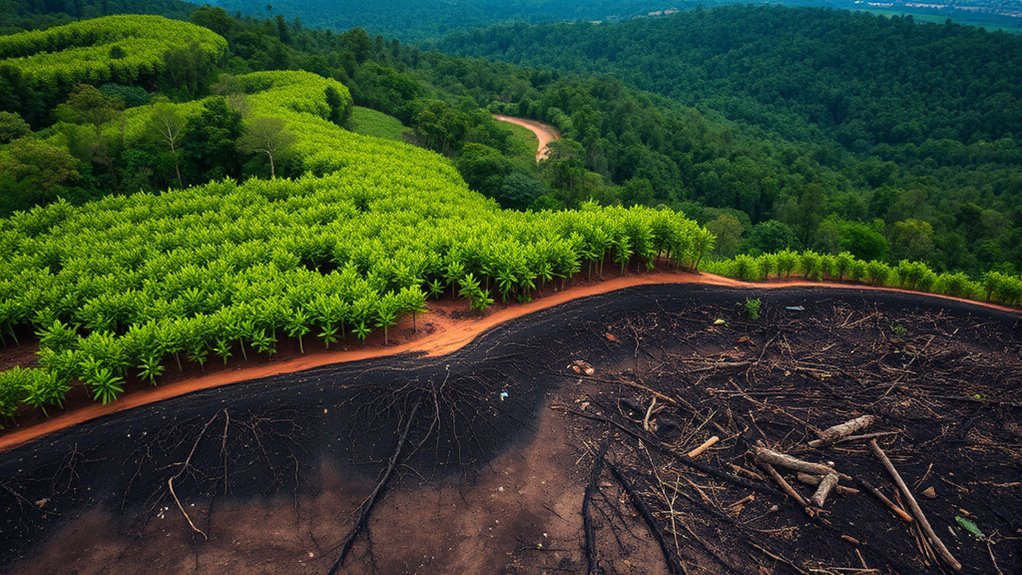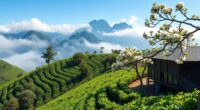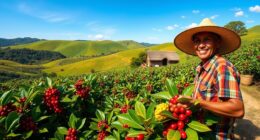Coffee cultivation often drives deforestation, as farmers clear forests to meet growing demand. This destroys habitats, releases stored carbon, and impacts climate change. However, sustainable farming practices like shade-grown coffee and reforestation efforts can reduce these effects. By choosing brands that prioritize eco-friendly methods, you can help protect forests and promote biodiversity. Want to discover how your coffee choices can make a difference? Keep exploring to find out more.
Key Takeaways
- Increasing demand for coffee drives large-scale land clearing, leading to deforestation in tropical regions.
- Deforestation destroys habitats, reduces biodiversity, and releases stored carbon, worsening climate change.
- Sustainable farming practices like shade-grown coffee help protect forests and promote ecological balance.
- Reforestation initiatives restore ecosystems, improve biodiversity, and stabilize local climates affected by deforestation.
- Consumer choices supporting eco-friendly coffee brands encourage industry shifts toward sustainable practices.

Have you ever wondered how your daily cup of coffee might be connected to the world’s forests? The truth is, the way coffee is grown has a significant impact on the environment, especially when it comes to deforestation. Many coffee farms are located in tropical regions where forests once thrived, but the demand for more land has led farmers to clear large areas of trees. This rampant clearing not only destroys habitats but also accelerates climate change through the release of stored carbon. However, there’s hope if you pay attention to how coffee is produced. Sustainable farming practices are transforming the industry by promoting methods that protect existing forests and even restore some of what’s been lost.
Your coffee choices can help protect forests and combat climate change through sustainable farming.
One effective approach is integrating sustainable farming techniques. These methods prioritize soil health, water conservation, and the preservation of natural vegetation. Coffee farmers who adopt sustainable practices often use shade-grown coffee, which involves growing coffee beneath a canopy of native trees. This method reduces the need to clear additional land and helps maintain biodiversity. Shade-grown coffee also encourages natural pest control, decreasing reliance on chemical pesticides that can harm ecosystems. By supporting coffee brands committed to sustainable farming, you can help push the industry toward more environmentally friendly practices and reduce the pressure to clear forests for new plantations.
Reforestation initiatives are another essential piece of the puzzle. Many organizations and local communities are actively working to replant trees in areas affected by deforestation. These reforestation efforts aim to restore ecosystems, improve biodiversity, and stabilize local climates. When you choose coffee from companies that invest in reforestation initiatives, you’re contributing to this positive change. These initiatives not only mitigate the environmental damage caused by deforestation but also improve the livelihoods of local farmers by providing forest-based products and creating new employment opportunities. Supporting such initiatives ensures that the land used for coffee cultivation is managed responsibly, with a focus on restoring and maintaining forest cover.
Ultimately, your choices matter. By buying coffee that emphasizes sustainable farming and supports reforestation initiatives, you’re helping to curb deforestation and promote healthier forests worldwide. You can also advocate for policies that incentivize eco-friendly practices in the coffee industry. Remember, every cup of coffee has a story, and that story can be one of environmental stewardship rather than destruction. When you become conscious of how your coffee is produced, you participate in a global effort to protect forests, sustain biodiversity, and combat climate change. Your simple act of choosing the right coffee can make a meaningful difference for the planet.
Frequently Asked Questions
How Does Deforestation Specifically Impact Coffee Quality?
When deforestation occurs, you’ll notice coffee quality drops because soil degradation worsens without trees to protect the soil. The loss of biodiversity also impacts pollinators, which are essential for healthy coffee plants. With fewer protective trees, your coffee plants become more vulnerable to pests and diseases, leading to inconsistent yields and inferior beans. So, deforestation directly harms your coffee’s flavor, aroma, and overall quality.
Are There Alternative Crops to Coffee That Cause Less Deforestation?
Yes, you can switch to crops like shade-grown coffee or other agroforestry systems that cause less deforestation. Shade-grown coffee preserves forest cover by growing under existing trees, reducing the need to clear land. Agroforestry systems integrate trees with crops, promoting biodiversity and soil health. These alternatives help protect forests while still providing economic benefits, making them a sustainable choice for farmers seeking to minimize environmental impact.
What Policies Can Governments Implement to Reduce Coffee-Driven Deforestation?
You can push for land use policies that prioritize sustainable farming practices and enforce strict environmental regulations. Governments should incentivize farmers to adopt shade-grown coffee and protect forested areas, making it clear that every little bit helps. By implementing clear guidelines and monitoring compliance, you help guarantee coffee cultivation doesn’t come at the expense of forests. Remember, a stitch in time saves nine—proactive policies can prevent widespread deforestation down the line.
How Do Consumer Choices Influence Deforestation Related to Coffee?
Your consumer choices directly influence deforestation related to coffee. When you prioritize consumer awareness and choose coffee with sustainable certifications, you support eco-friendly practices that protect forests. Opting for certified brands encourages farmers to adopt sustainable methods, reducing deforestation. By making conscious purchasing decisions, you help drive demand for environmentally responsible coffee, fostering a shift towards sustainable agriculture that safeguards forests and promotes healthier ecosystems.
Can Reforestation Efforts Balance Coffee Production Needs?
Reforestation efforts can help balance coffee production needs, but they face challenges like land availability and funding. You can support coffee sustainability by choosing brands committed to reforestation projects and sustainable practices. While reforestation isn’t a complete fix, it plays a crucial role in restoring ecosystems and ensuring future coffee supplies. Your choices matter, and supporting reforestation helps address these challenges and promotes a more sustainable coffee industry.
Conclusion
As you walk through lush coffee plantations, imagine the vibrant green leaves giving way to barren, cracked earth. Every tree lost whispers a story of deforestation’s toll—decreasing biodiversity, threatening livelihoods, and warming our planet. But you hold the power to make a difference. By supporting sustainable practices and protecting these forests, you can help restore the beauty and balance of these precious lands, ensuring future generations still wake up to the rich aroma of coffee amidst thriving, green canopies.









